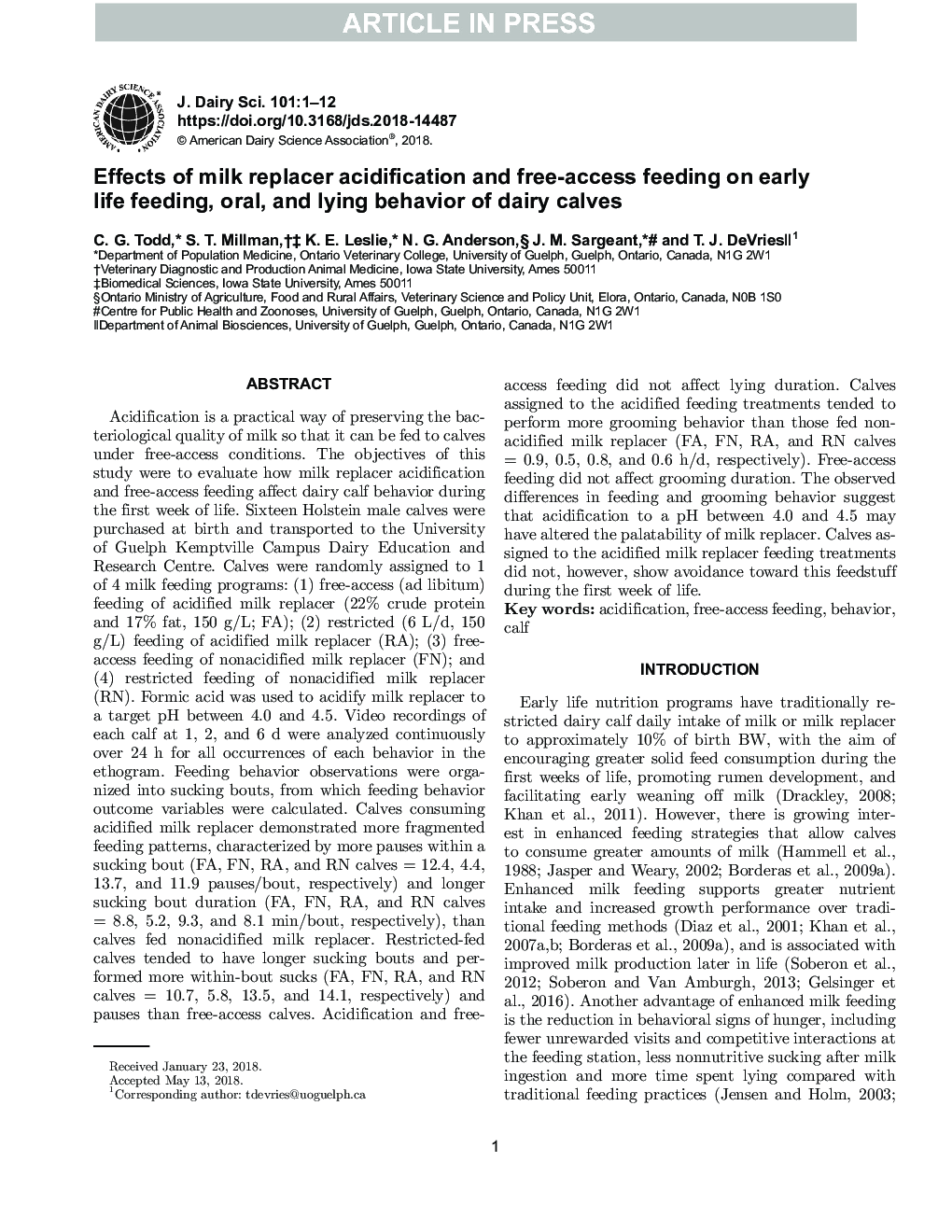| کد مقاله | کد نشریه | سال انتشار | مقاله انگلیسی | نسخه تمام متن |
|---|---|---|---|---|
| 8956481 | 1646155 | 2018 | 12 صفحه PDF | دانلود رایگان |
عنوان انگلیسی مقاله ISI
Effects of milk replacer acidification and free-access feeding on early life feeding, oral, and lying behavior of dairy calves
ترجمه فارسی عنوان
تأثیر اسیدیته جایگزین شیر و تغذیه بدون دسترسی در تغذیه زودرس، رفتار خوراکی و دروغ گوساله های شیری
دانلود مقاله + سفارش ترجمه
دانلود مقاله ISI انگلیسی
رایگان برای ایرانیان
کلمات کلیدی
اسیدی کردن، تغذیه رایگان دسترسی، رفتار - اخلاق، گوساله،
موضوعات مرتبط
علوم زیستی و بیوفناوری
علوم کشاورزی و بیولوژیک
علوم دامی و جانورشناسی
چکیده انگلیسی
Acidification is a practical way of preserving the bacteriological quality of milk so that it can be fed to calves under free-access conditions. The objectives of this study were to evaluate how milk replacer acidification and free-access feeding affect dairy calf behavior during the first week of life. Sixteen Holstein male calves were purchased at birth and transported to the University of Guelph Kemptville Campus Dairy Education and Research Centre. Calves were randomly assigned to 1 of 4 milk feeding programs: (1) free-access (ad libitum) feeding of acidified milk replacer (22% crude protein and 17% fat, 150 g/L; FA); (2) restricted (6 L/d, 150 g/L) feeding of acidified milk replacer (RA); (3) free-access feeding of nonacidified milk replacer (FN); and (4) restricted feeding of nonacidified milk replacer (RN). Formic acid was used to acidify milk replacer to a target pH between 4.0 and 4.5. Video recordings of each calf at 1, 2, and 6 d were analyzed continuously over 24 h for all occurrences of each behavior in the ethogram. Feeding behavior observations were organized into sucking bouts, from which feeding behavior outcome variables were calculated. Calves consuming acidified milk replacer demonstrated more fragmented feeding patterns, characterized by more pauses within a sucking bout (FA, FN, RA, and RN calves = 12.4, 4.4, 13.7, and 11.9 pauses/bout, respectively) and longer sucking bout duration (FA, FN, RA, and RN calves = 8.8, 5.2, 9.3, and 8.1 min/bout, respectively), than calves fed nonacidified milk replacer. Restricted-fed calves tended to have longer sucking bouts and performed more within-bout sucks (FA, FN, RA, and RN calves = 10.7, 5.8, 13.5, and 14.1, respectively) and pauses than free-access calves. Acidification and free-access feeding did not affect lying duration. Calves assigned to the acidified feeding treatments tended to perform more grooming behavior than those fed nonacidified milk replacer (FA, FN, RA, and RN calves = 0.9, 0.5, 0.8, and 0.6 h/d, respectively). Free-access feeding did not affect grooming duration. The observed differences in feeding and grooming behavior suggest that acidification to a pH between 4.0 and 4.5 may have altered the palatability of milk replacer. Calves assigned to the acidified milk replacer feeding treatments did not, however, show avoidance toward this feedstuff during the first week of life.
ناشر
Database: Elsevier - ScienceDirect (ساینس دایرکت)
Journal: Journal of Dairy Science - Volume 101, Issue 9, September 2018, Pages 8236-8247
Journal: Journal of Dairy Science - Volume 101, Issue 9, September 2018, Pages 8236-8247
نویسندگان
C.G. Todd, S.T. Millman, K.E. Leslie, N.G. Anderson, J.M. Sargeant, T.J. DeVries,
